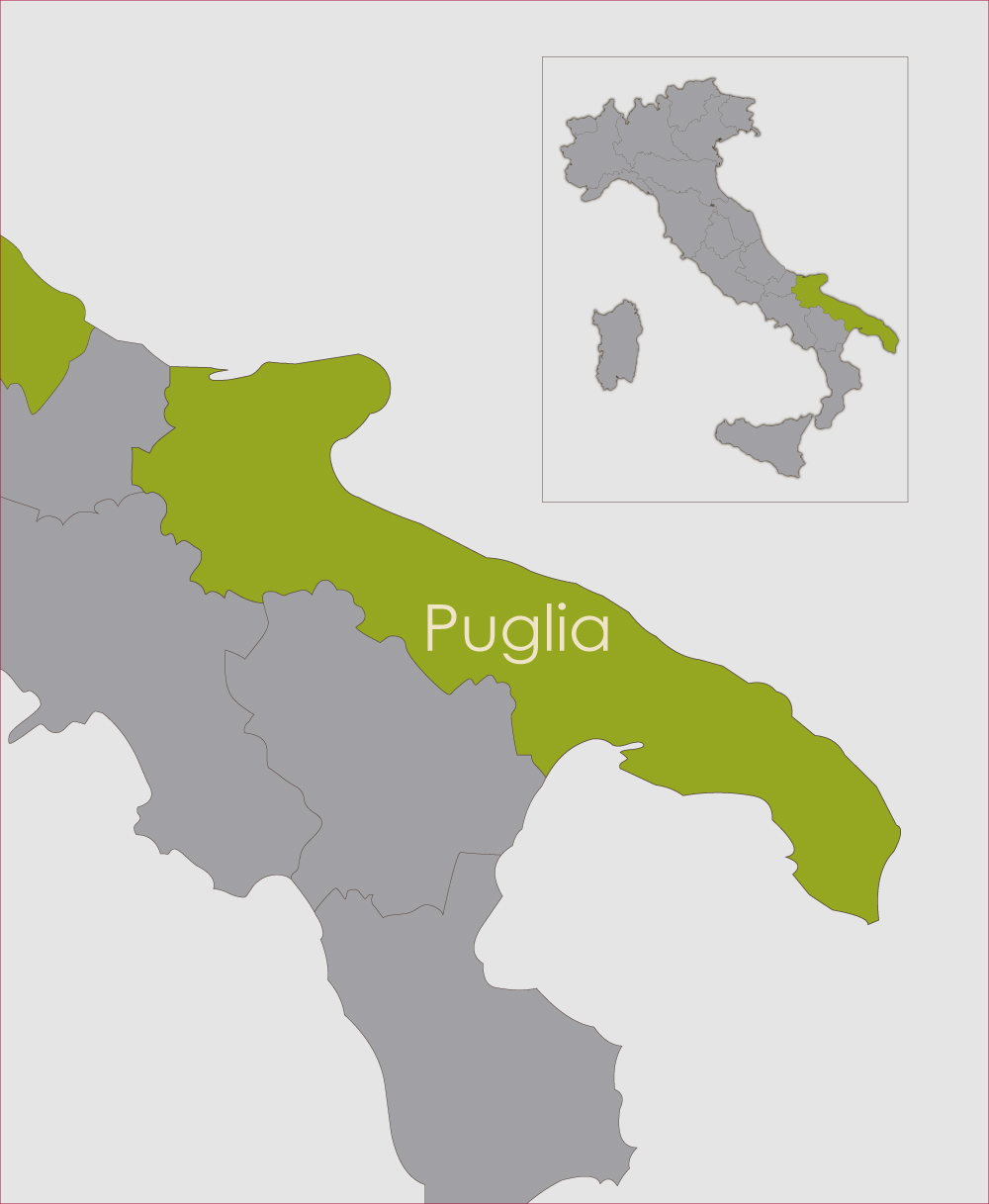 |
FAST FACTS
PRODUCERS CONTRADE, MASSERIA LI VELI |
OVERVIEW
Puglia is one of the easiest Italian regions to locate, forming the southeastern appendage that is universally described as the heel on the boot-shaped Italian Peninsula. The area was known as Apulia to the Romans, and that name is sometimes used in English-language contexts as well. Puglia has always been a major wine-producing region, and in the last few years, Puglia’s production has increased significantly, moving it into second place among the Italian regions (after Veneto). Its capital and largest city is Bari, a major port that connects southern Italy with eastern Mediterranean countries by sea.
History: Puglia has always had connections with the east and to a lesser extent Africa due to its position at the end of the Italian Peninsula. The major Mediterranean power prior to the Romans—the Greeks—established numerous colonial settlements along the Puglian coast beginning more than 3,000 years ago. Though Italy already had grapevines, these colonists brought other varieties from their homeland, which added to the diversity of Italy’s viticulture. The Romans later absorbed these Greek colonies, along with their vines and winemaking expertise.
After the empire fell, Puglia remained a part of the Eastern Roman (Byzantine) Empire for most of the next five or six centuries. Eventually, the area was taken over by an army of Normans who decided to stay in the Mediterranean after fighting in the Crusades rather than return to France. From the 11th until the mid-19th century, the region was part of the Duchy of Puglia and Calabria, the Kingdom of Sicily, the Kingdom of Naples, the Kingdom of the Two Sicilies, and finally the Kingdom of Italy in 1861.
Geography: Puglia comprises the lower 210 miles (340 km) of the Italian Adriatic Sea coastline. It is the least mountainous region in Italy, because it basically includes only the coastal zone between the sea and the Apennine Mountains. Thus, it is relatively narrow, averaging about 35 miles (55 km) wide.
The southernmost part of Puglia—the actual “heel”—is the 75-mile-long (120 km) Salento peninsula, which extends between the Adriatic and Ionian seas. The northern end of Puglia is marked by the Gargano peninsula, the metaphorical spur of the boot. This promontory is formed by an incongruous mountain that’s essentially a misplaced part of the Apennines. The principal peak of the Gargano is 3,500-foot (1,065 m) Monte Calvo, the highest point on the western shore of the Adriatic.
Climate: The majority of Puglia is within a few miles of the sea and low in elevation, so a classic Mediterranean climate prevails. Summers are hot, dry, and sunny, while winters are mild and rainy. Along the western border with Basilicata and Campania, the higher-elevation plateaus of Murgia and Tavoliere experience a more continental climate, featuring hotter summers and colder winters with occasional snow.
Primary grape varieties: The warm climate of Puglia dictates that red wines and dessert wines will be more successful than whites or sparkling wines. Accordingly, the top four grape varieties planted in the region are red. They are not equally dispersed, however. Negroamaro (also spelled Negro Amaro) is concentrated in the south, in Salento. In the center of the region, Primitivo is dominant. And in the northern provinces, Montepulciano and Sangiovese hold court. The leading white grape varieties planted in Puglia are members of the Trebbiano group.
Despite the prominence of that handful of grape varieties, there are dozens of other varieties with significant acreage in Puglia that are important to Puglia’s diverse portfolio of wines. International grape varieties are present, naturally, but they do not represent a particularly large proportion of the vineyards. Instead, the roster is populated with interesting local color such as Uva di Troia, Bombino Nero, and Susumaniello among the reds and Cococciola, Verdeca, and Pampanuto among the whites.
Key wine regions: Few of Puglia’s denominations are well known internationally. The primary exception to that characterization is Salice Salentino DOC, a Negroamaro-based wine from Salento. Farther north, Primitivo di Manduria DOC (for Primitivo) and Castel del Monte DOC (for a number of different wines) also have an export presence. Most of the quality wine production goes into one of six IGPs, the largest of which are IGP Puglia for the whole region and IGP Salento for just the southern peninsula.
Cuisine: Puglia is one of the key agricultural regions of Italy due to its climate and lack of mountainous terrain. A plethora of agricultural products is grown here, including a lot of wheat for pasta, as well as fruits, nuts, and vegetables. Thus, the regional cuisine is able to draw on a wide variety of fresh ingredients. Dishes are simple, but bursting with flavor.
Pasta is an important part of Puglian cuisine, and it appears in many forms. The best-known traditional pasta shape is the cup-like shells called orechiette (“little ears”), although numerous other variants of strings, tubes, and ribbons—several of them unique to Puglia—are also served. Sauces usually include vegetables or seafood; meat (ragù di carne) is less common. Cime di rape, or broccoli rabe as it might appear on a U.S. menu, is a classic partner for Puglian pasta.
Main courses anywhere near the coast are usually built around seafood. Many types of fish and shellfish are readily available. Octopus is a particular delicacy. Pasta or rice may be incorporated into the dish. Meats are typically lamb, goat, or possibly horse. Pork, beef, and poultry are not unheard of, but they are not traditional in Puglia.
Desserts are often fried doughs flavored with almonds and sweetened with honey, figs, or Marsala. A traditional treat in Salento is pasticciotto, a small pie filled with custard.

